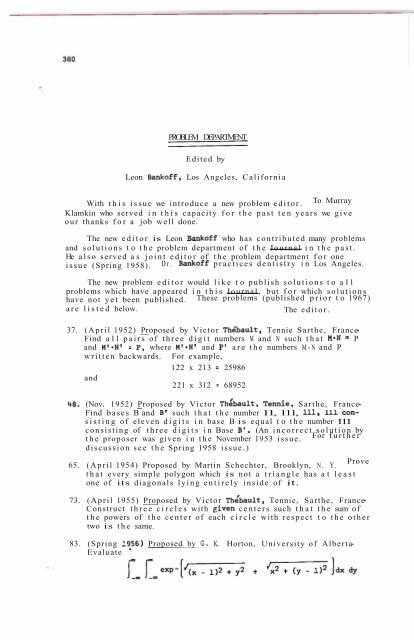Vol. 4 No 9 - Pi Mu Epsilon
Vol. 4 No 9 - Pi Mu Epsilon
Vol. 4 No 9 - Pi Mu Epsilon
You also want an ePaper? Increase the reach of your titles
YUMPU automatically turns print PDFs into web optimized ePapers that Google loves.
91. (Fall 1956) Proposed by Nathaniel Grossman, California Instituteof Technology Prove thatPROBLEM DEPARTMENTEdited byLeon Bankoff, Los Angeles, CaliforniaWith this issue we introduce a new problem editor. To <strong>Mu</strong>rrayKlamkin who served in this capacity for the past ten years we giveour thanks for a job well done.The new editor is Leon Bankoff who has contributed many problemsand solutions to the problem department of the Journal in the past.He also served as joint editor of the problem department for oneissue (Spring 1958). Dr. Bankoff practices dentistry in Los Angeles.The new problem editor would like to publish solutions to allproblems which have appeared in this Journal, but for which solutionshave not yet been published. These problems (published prior to 1967)are listed below.The editor.37. (April 1952) Proposed by Victor ~hebault, Tennie Sarthe, FranceFind all pairs of three digit numbers M and N such that M'N = Pand MI-N' = P, where MI-N' and P' are the numbers M-N and Pwritten backwards. For example,122 x 213 = 25986and221 x 312 = 68952(<strong>No</strong>v. 1952) Proposed by Victor ~hgbault. Tennie, Sarthe, FranceFind bases B and B' such that the number 11, 111, 111, Ill consistingof eleven digits in base B is equal to the number 111consisting of three digits in Base B'. (An incorrect solution bythe proposer was given in the <strong>No</strong>vember 1953 issue.For furtherdiscussion see the Spring 1958 issue.)Prove65. (April 1954) Proposed by Martin Schechter, Brooklyn, N. Y.that every simple polygon which is not a triangle has at leastone of its diagonals lying entirely inside of it.73. (April 1955) Proposed by Victor ~hebault, Tennie, Sarthe, FranceConstruct three circles with ffiven centers such that the sum ofthe powers of the center of each circle with respect to the othertwo is the same.83. (Spring 1956) Proposed by G. K. Horton, University of AlbertaEvaluate '1 a(-) @(dl = n ~(n)dwhere ~(n) denotes the number of divisors of n, a(n) is the sum ofthe divisors of n and +(n) is the Euler Totient function.102. (Fall 1958) Proposed by Leo Moser, University of Alberta Give acomplete proof that two equilateral triangles of edge 1 cannot beplaced, without overlap, in the interior of a square of edge 1.120. (Spring 1960) Proposed by Michael Goldberg, Washington, D. C.1. A l l the orthogonal projections of a surface of constant widthhave the same perimeter. Does any other surface have this property?2. A sphere may be turned through all orientations while remainingtangent to the three lateral faces of a regular triangular prism.Does any other surface have this property? <strong>No</strong>te that a solution to2. is also a solution to 1.128. (Spring 1961) Proposed by Robert P. Rudis and Christopher Sherman,AVCO RAD Given 2n unit resistors, show how they may be connectedusing n single pole single throw (SPST) and n single pole doublethrow (SPDT) (the latter with off position) switches to obtain,between a single fixed pair of terminals, the values of resistanceof i and i'l where i = 1,2,3,. . . ,2n.Editorial <strong>No</strong>te:Two more difficult related problems would be toobtain i and i using the least number of only one of the abovetype of switches.(Fall 1961) Pro p osed b y Michael Goldberg,Washin ton, D. C. Whatis the smallest convex area which can be rotatedgcontinuo~slywithin a regular pentagon while keeping contact with all thesides of the pentagon? This problem is unsolved but has beensolved for the square and equilateral triangle. For the square, itis the regular tri-arc made of circular arcs whose radii are equalto the side of the square. For the triangle, it is the two-arcmade of equal 60Â arcs whose radii are equal to the altitude ofthe triangle.(Fall 1962) Proposed by Huseyin Demit, Kandilli, Eregli, Kdz., TurwFind the shape of a curve of length L lying in a vertical plane--and having its end points fixed in the plane, such that when itrevolves about a fixed vertical line in the plane, generates avolume which when filled with water shall be emptied in a minimumof time through an orifice of given area A at the bottom. (<strong>No</strong>te:The proposer has only obtained the differential equation of thecurve. )(Fall 1964) Proposed by Leo Moser, University of Alberta Show that5 points in the interior of a 2x1 rectangle always determine at leastone distance less than sec 15O.
















